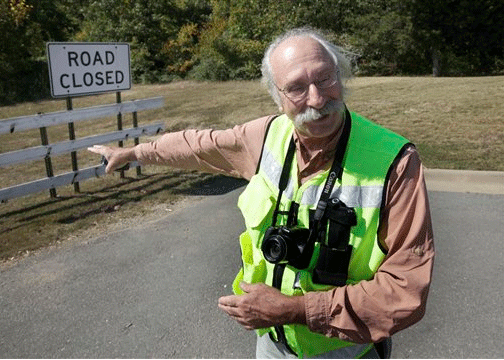
Oct. 7, 2011: Dan Burden discusses his ideas on fewer and smaller streets at an intersection in North Little Rock, Arkansas. Instead of making streets wider to accommodate more cars, crews will reduce them from four lanes to two in a project called a "road diet." (AP)
Harrison, Arkansas – It looks like any other road-improvement project: orange barrels, repaving equipment and men in fluorescent vests. But a closer look reveals something curious.
Instead of making the street wider to accommodate more cars, the crew reduces it from four lanes to two in a project called a "road diet." The goal is to rein in aggressive drivers and make shopping areas friendlier to pedestrians.
The idea seems counterintuitive for traffic-choked towns, but it's catching on. In Harrison, a small city in northwest Arkansas, officials also hope it drums up more business along Main Street. Mayor Jeff Crockett wants drivers "to slow down, stop, shop, take your time getting through."Some people say the plan seems to be working, citing an increase in foot traffic at stores. Others worry that the new configuration will have the opposite effect: If traffic backs up too much, people will flee Main Street for other routes.
"We're afraid of people avoiding this area," said Kristi Myers, who runs a tire and battery shop with her husband along the newly paved street. "If someone doesn't want to come down this road, less traffic means less business for us."
Road diets -- and doubts about them -- are not entirely new. A decade ago in University Place, Wash., city officials faced opposition when they eliminated some traffic lanes.
"The idea that you can take lanes away seems to some to be insanity," said Steve Sugg, city manager in the community about 40 miles southwest of Seattle.
Yet in University Place and scores of other communities that have taken similar measures, motorists are often pleasantly surprised. Commutes don't take much longer, and more drivers follow the speed limit, largely because they have no more passing lanes.
In Harrison, the road was narrowed to two driving lanes, with a turn lane in the middle.
But business owners such as Ernest Raney, who runs a pawn shop with his wife along Main Street, question whether it will achieve anything for businesses.
"They call it a road diet, which means they're going to cut back on traffic," Raney said. "But I can't imagine any businessman wanting less traffic in front of his business."
The pace of life has always been slow in this city of 13,000. People honk their horns to say hello, not to criticize someone's driving. Sales clerks and supermarket baggers know customers by name.
Traffic here hardly qualifies as gridlock compared with major metropolitan areas. More often than not, tourists headed north to Branson, Mo., or south to kayak on the Buffalo River bypass the city's downtown. And for visitors who venture onto the city's Main Street, there's not much to stop for.
City officials want the road diet to change that.
"Our hope is that it will spur more business development and growth," said Terry Cook, who runs the visitors bureau.
Road diets have served as economic-development tools in other communities, including Chandler, Ariz., where people working at office complexes used to climb behind the wheel if they wanted to cross the street for lunch.
Business has shot up since the suburb outside Phoenix completed a road diet last fall. Sales tax receipts are up, and more than a dozen new companies opened downtown, according to Teri Killgore, the downtown redevelopment manager.
Harrison completed its road diet only a few weeks ago, so it's too soon to know whether the new system will pay off.
So far, foot traffic at Lana Trublood's flower shop has more than doubled now that drivers can turn into her store more easily. Some customers told her they had wanted to stop by in the past but didn't want to risk opening their car doors into fast-moving traffic.
Down the street, at the pawn shop, Raney told a different story.
"I haven't heard anybody say they spotted this place because they were going slower," he said with a laugh.
In fact, he and his wife, Marie, say they haven't heard much positive feedback at all, except from customers who comment that the road is now smoother.
That would have happened anyway. The state resurfaced more than three miles of the street this year, including the 1.3 miles where the city got rid of a lane. The project cost $1.1 million -- the same price without the road diet, since workers simply paint lines in different spots, according to the state highway and transportation department.
Much remains unchanged. Cars still zip by stores and screech to a halt at stoplights. The speed limit is the same.
Still, Dan Burden, who pushes road diets and other transportation ideas to make communities more walkable, says the road diet fits nicely with Harrison's goal of gleaning more revenue from its businesses.

